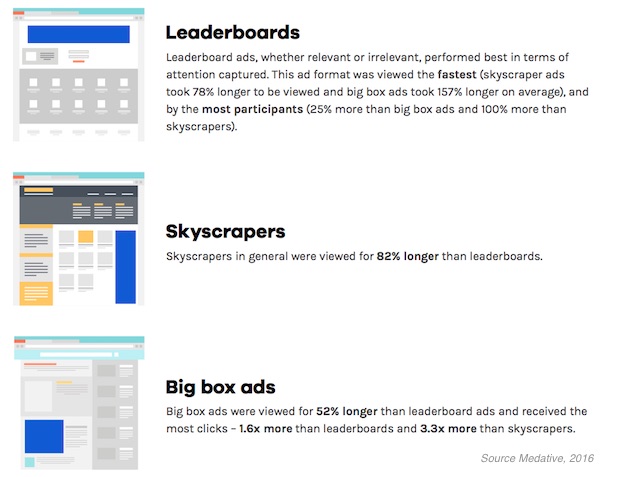Do consumers actually notice online display ads served on Web pages? Which format of ads do people look at and engage with the most?
To find out, Meditative conducted an eye-tracking study of 39 participants of mixed ages who were assigned certain search tasks.
Digital display ads were shown in the leaderboard (728x90), skyscraper (300x600) and big box (300x250) positions across both Web-page mock-ups and actual sites.
With data from the study, the researchers were able to generate heat maps showing the length of time spent looking at various parts of the pages, as well as gaze maps indicating where people clicked.

Overall, 16.6% of the ads that were served to study participants were viewed (e.g., 50% or more of their pixels were in view for a minimum of one second). Some 50% more ads were viewed above the Web-page fold compared with below the fold, and ads above the fold were viewed for 87% longer, on average.
Digital display ads were 80% more likely to be noticed by study participants if they were relevant to a task the searcher was currently working on, compared with ads relevant to something the searcher had looked for in the past.
Leaderboards, the horizontal ads served at the top of pages, were seen most (25% more, on average, compared with big box ads) and were also noticed most quickly. However, they were viewed for the shortest amount of time, on average.
Skyscrapers, the vertical display ads served along sides of Web pages, were viewed by participants for the longest amount of time, on average (82% longer than leaderboards).
Big box ads, the square units served in various spots on pages, were seen by fewer participants compared with leaderboards and viewed for shorter amounts of time compared with skyscrapers. However, these units garnered the most clicks (1.6x more than leaderboards and 3.3x more than skyscrapers, on average).
About the research: The report was based on an eye-tracking study of 39 participants of mixed age and gender who were assigned certain search tasks. Digital display ads were shown in the leaderboard (728x90), skyscraper (300x600) and big box (300x250) positions across both Web-page mock-ups and actual sites.





